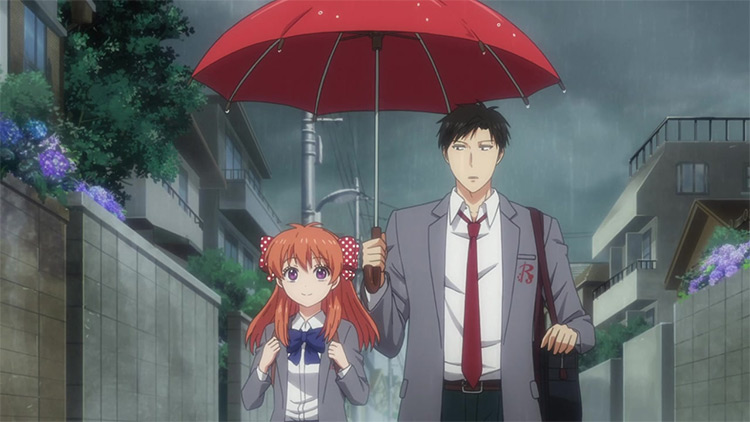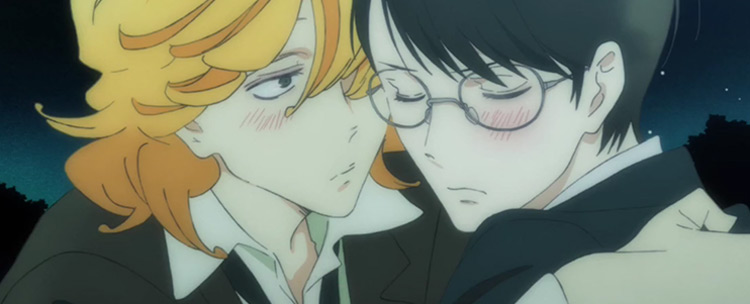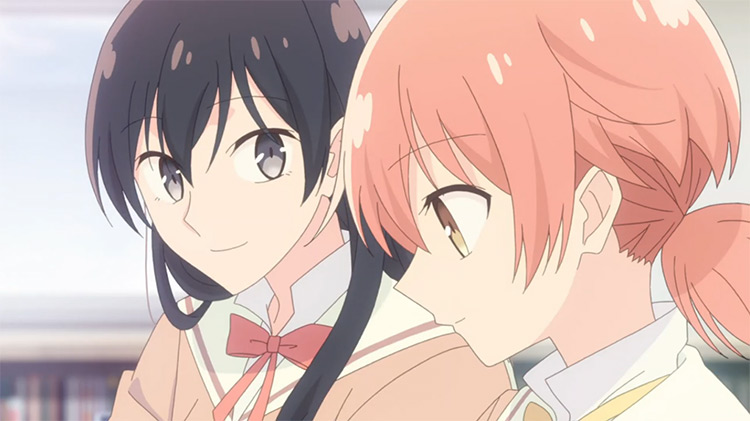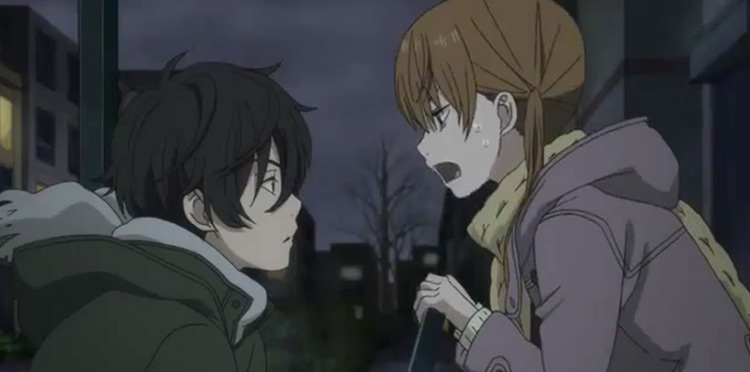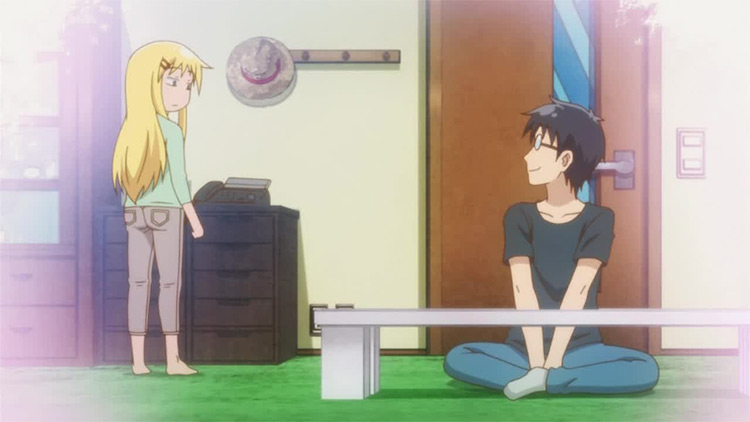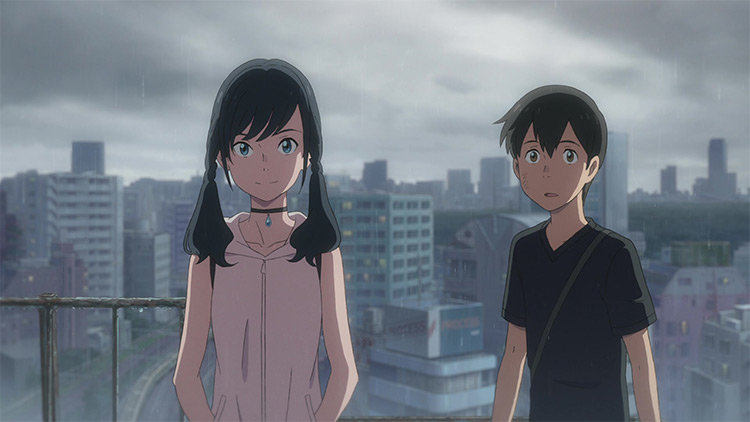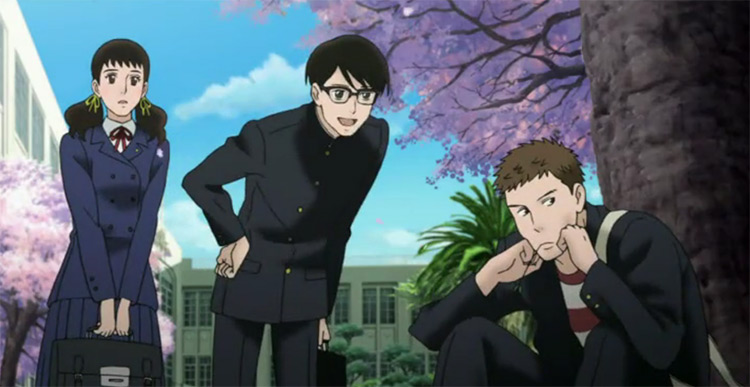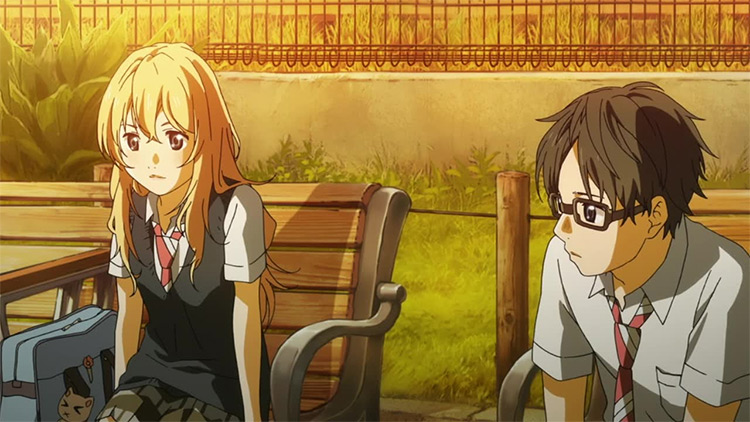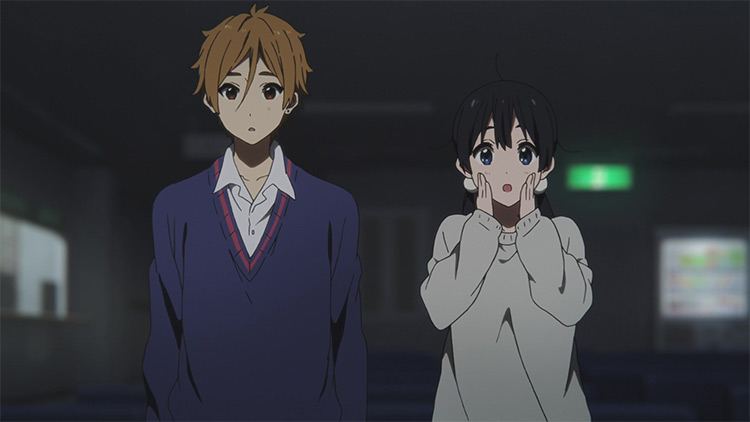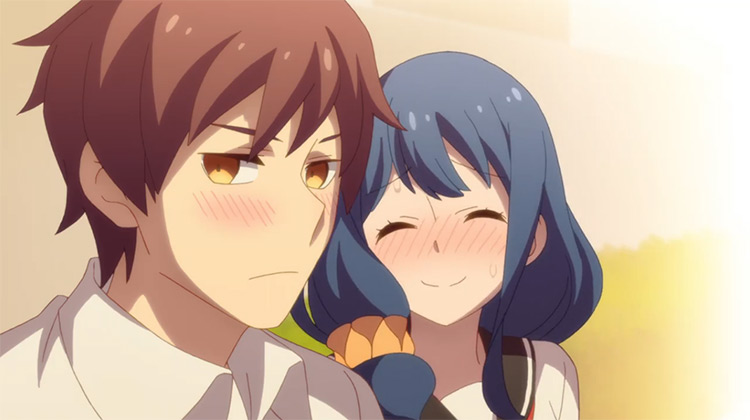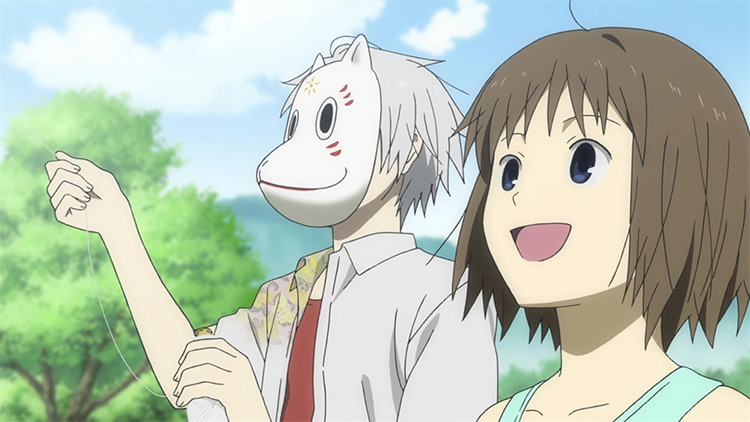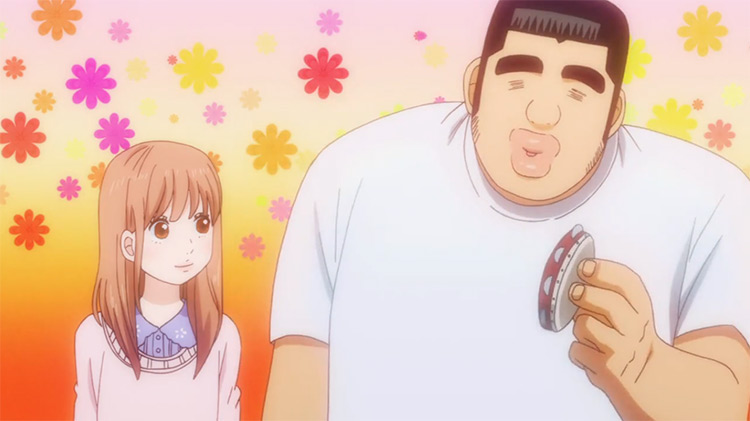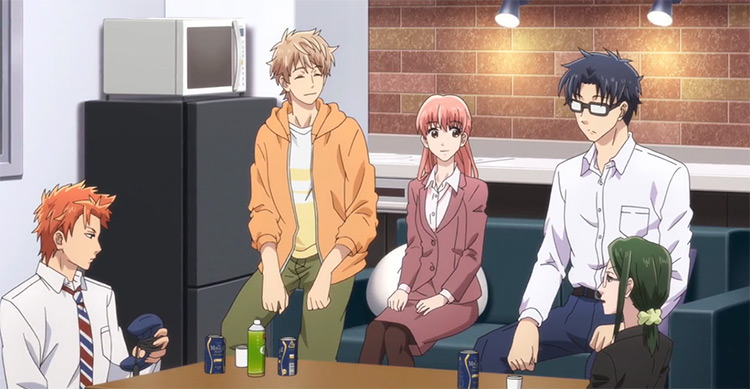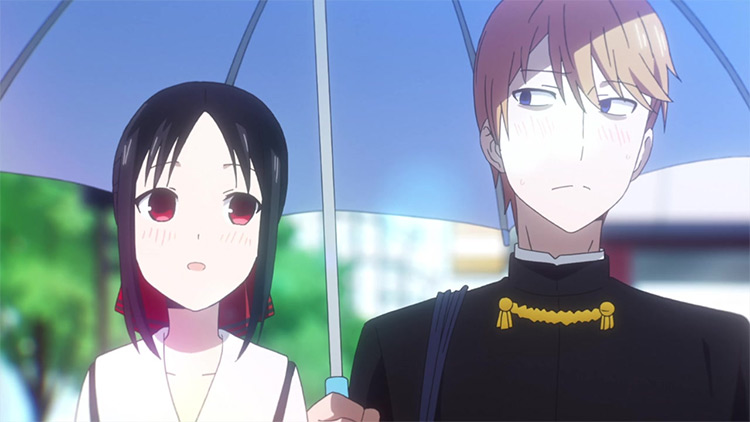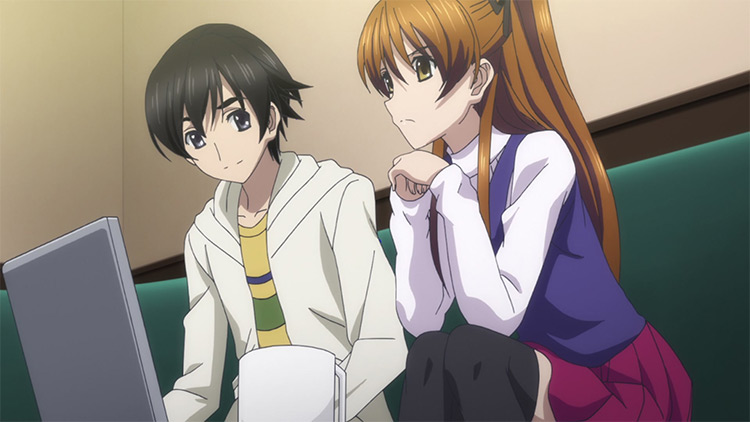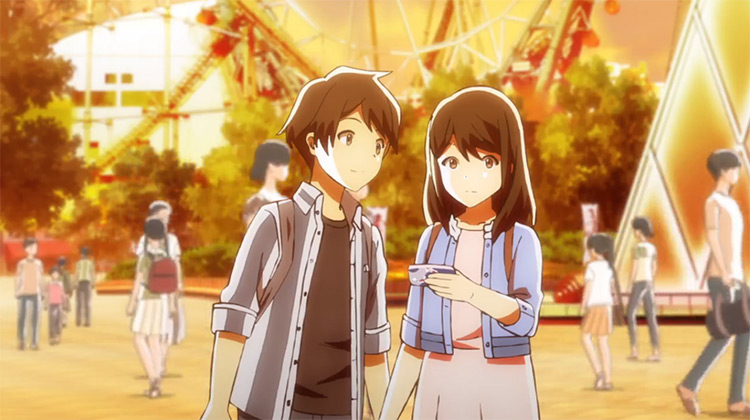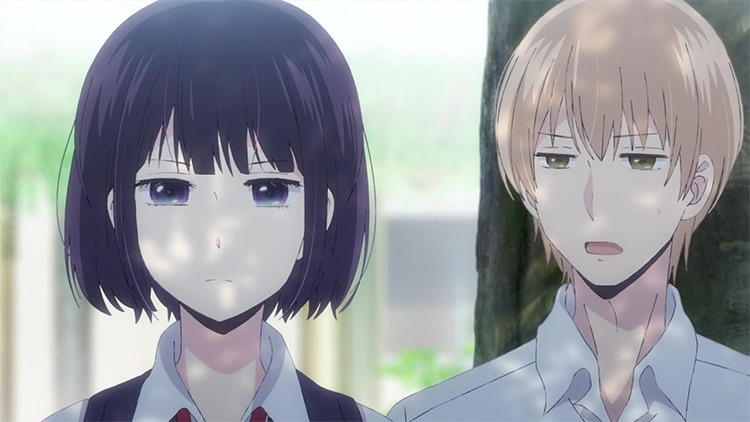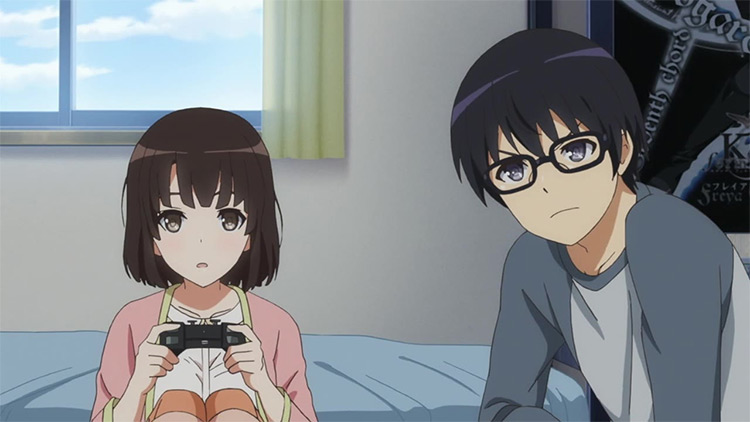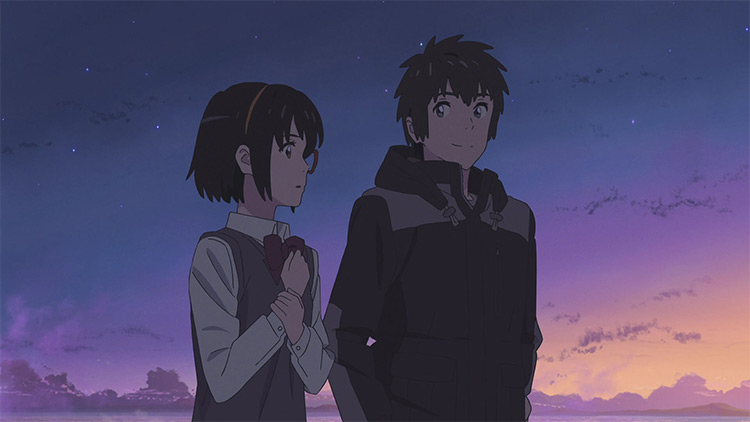In the field of romance, anime once again introduced unforgettable characters and relationships in all sorts of settings, from high school (of course) to the workplace. So which shows left a strong, lasting impression? Here are my favorite romance anime picks of the 2010s — a whole decade of doki dokis and heart-stirring (or heartbreaking) moments captured for eternity.
20. Monthly Girls’ Nozaki-kun
Starting this legendary list is Gekkan Shoujo Nozaki-kun, one of the best anime series of 2014. This show made me aware of Doga Kobo and its strength in adorable character animation — and it’s a show many are begging for a second season. Monthly Girls’ Nozaki-kun is about the cute and jolly Chiyo Sakura’s affection toward Umetarou Nozaki. No, this isn’t about her being too nervous to confess. She does admit her feelings for him, but Umetarou is a dense rom-com male MC. But here’s the funny part: Umetarou is a popular shoujo manga artist. Thus, he devotes a lot of time to researching and improving his understanding of romance. Yet he hasn’t had his first love and always has funny misunderstandings with Chiyo. The humor and developments here may not be innovative, but this is a well-executed school romance. It already has a solid main couple, but Monthly Girls’ Nozaki-kun has stellar supporting characters. You get the seemingly loud guy who’s actually tender and tsundere-like, and a princely girl admired by other girls but has trouble improving her relationship with her guy crush.
19. Doukyuusei -Classmates-
Doukyuusei is a much-needed film, especially for those still yearning for proper representation in media and fiction. This 60-minute movie stars two male high school students preparing for the chorus competition. There’s the chill and long-haired Hikaru who isn’t particularly superb in academic matters or any school activities. Then there’s Rihito Sajou, a smart and stern-looking guy who isn’t doing well during practice. Thus, it’s up to Hikaru to help Rihito improve his singing. As you might expect, the two soon realize that their contrasting personalities and perspectives can’t stop them from developing feelings for each other — and it’s wonderful. Doukyuusei isn’t merely about sweet moments, but it also doesn’t step into excessive melodrama. At its core, it’s about two teenagers being teenagers: They fall in love, determine priorities in life, and find people who will accept them for who they are – even if society still isn’t completely accepting of all forms of love.
18. Bloom Into You
Released two years earlier than the similarly noteworthy Adachi and Shimamura, Bloom Into You centers on love and self-realization. If Doukyuusei had two high school boys traversing love and other emotions, this anime has two high school girls: Yuu Koito knows all about shoujo romance, yet hasn’t had any first-hand experience with love herself. She finds the student council president, Touko Nanami, to be an admirable girl — but she wasn’t expecting a confession from her. Did Yuu reciprocate Touko’s feelings and become her girlfriend? No, and that’s the complex beauty and realism of Bloom Into You. Yuu needs time to discover herself and understand why she feels lonely. Likewise, Touko has insecurities to confront, especially since she thinks that she’s not worthy of being loved. And the series also depicts subtle and realistic instances of homophobia, among many other issues. Bloom Into You is a nuanced and polished look into the lives (and love life) of two teenage girls. And it’s a reminder that not all anime series about lesbians are hyper-charged and scandalous.
17. My Little Monster
Just like Monthly Girls’ Nozaki-kun, Tonari no Kaibutsu-kun is a school rom-com from the early 2010s that easily deserves a second season. Both have lovely opening themes and background tracks. They have an open-ended final episode that’s barely a season-ender and more of a huge cliffhanger. So, what’s up with My Little Monster? The main girl is Shizuku Mizutani, a high schooler whose only focus is studying. In contrast, Haru Yoshida is considered a delinquent, but is caring and wants to make friends with others (not scare them away). One day, Shizuku is tasked to deliver the absentee Haru’s printouts. Their unlikely friendship starts — and something more than this blossoms. But first, the two must face their personal and social troubles. Despite their differences, the two both don’t know how to properly communicate with other people. Moreover, other relationships are worth looking into, particularly that between the web-savvy Asako Natsume and the much older Mitsuyoshi Misawa. And perhaps most importantly, the show has a pet rooster named Nagoya.
16. I Can’t Understand What My Husband Is Saying
Danna ga Nani wo Itteiru ka Wakaranai Ken is unlike any other show on my list: It’s a very short TV series. You can finish both seasons in a little over 60 minutes, but you can also enjoy one episode a week. The loli Kaoru and otaku Hajime Tsunashi are newlyweds. They’re young adults who are just beginning to understand what it truly means to be together with the one you love. It’s their first time thinking about having kids and their long-term health and career. They’re imperfect, but have each other — and that’s what matters. If you’ve had your fair share of anime, then this rom-com will even be more rewarding. Its references to various otaku media are plentiful, and appear at the perfect time. And its quick runtime doesn’t mean it’s lacking depth: This 4-koma manga fills each episode with comedy, snippets of domestic life, and surprisingly heartfelt, relatable musings and conversations (this is a seinen, after all). One moment you’re laughing with them, then the next moment you’re thinking about your own life, as the characters suddenly realize they’re happy right where they are.
15. Weathering With You
Tenki no Ko is Makoto Shinkai’s follow-up to the record-breaking Your Name., the film that broke anime records in several countries and made him a household name. But while Weathering With You couldn’t match the hype and acclaim, it was still one of the best anime movies of the 2010s — romance or not. Here’s why it has a special place in my heart: Apart from themes of family, distance, and a colorful portrayal of youth and their passions and struggles, which you’ll often find among Shinkai projects, Tenki no Ko feels like a reflection of Generation Y and Z. The film’s fantasy element is that Tokyo has unending rainy weather (and that someone can fix it, albeit without permanent consequences). Yet this unrealistic occurrence is a reminder of the sins of the past generations: Environmental neglect, rampant urban development, and cynicism, among many others. Of course, the youth today also want to live freely, building friendships and chasing love without a care. But the reality is that they now have to grapple with economic, political, and environmental problems the older generations started and failed to stop. The main characters of Weathering With You share this real-life frustration. And it’s why the romance, the hindrance to this romance, and the ‘controversial’ ending get better the more you think about them.
14. Kids on the Slope
The Studio MAPPA today is significantly different from its first iteration. Before it became known for big shounen adaptations, its most prominent titles were Watanabe’s works such as Terror in Resonance and this jazzy masterpiece, Kids on the Slope. Sakamichi no Apollon is a josei romance drama featuring three high schoolers: The bespectacled pianist Kaoru Nishimi, the drummer and delinquent Sentarou Kawabuchi, and the kindhearted Ritsuko Mukae. And what’s even better is that it’s not a modern teen romance. Kids on the Slope is set in the 1960s. With music from the legendary Yoko Kanno and flawless direction from Watanabe, the series is such a splendid watch. It sounds great, flows well, and knows when to put jazz, drama, friendship, or romance at the forefront. Even if you weren’t around during the 1960s, you’ll still feel nostalgic. After all, this is a coming-of-age story. And the developments in their social dynamics will remind you of how your first friendships and romantic relationships changed as you met more people.
13. Your Lie in April
This might be a big surprise to many, but Shigatsu wa Kimi no Uso didn’t make it to my top 10 for this ranking – which isn’t really a big deal. The show could’ve presented the heavier or melodramatic parts better, but the more romantic and life-affirming sequences more than compensate for them. As one of the most acclaimed anime series of the 2010s, Your Lie in April has stunning performances — and I’m not just referring to the piano and violin sequences. A-1 Pictures let viewers know each character by merely looking at their faces and overall demeanor. From Kousei’s timid nature and sudden changes in expression to Kaori Miyazono’s infectious glee and energy, Your Lie in April knows that musical performances are made more memorable precisely due to who’s playing the instrument, that they’re telling a story through sound. Likewise, Ryouta Watari and Tsubaki Sawabe are compelling. One gorgeously animated scene between Tsubaki and Kousei may just break your heart into pieces. Shigatsu wa Kimi no Uso is unlike your ordinary teen romance. It juggles youthful passion, trauma, friendship, first love, and white lies, reminding folks that not all can have what they want and that they must choose whether to be selfish or heartwarmingly (yet painfully) selfless. This is about life, choices (and how limited they can be), romance, and romance that could’ve been.
12. Tamako Love Story
Yes, the award-winning sequel movie to the slice-of-life series from Kyoto Animation is a surefire way to believe in love again. The 2013 series was more about the shopping district and its eccentric and wholesome community. It had Tamako Kitashirakawa interacting with everyone from the florist Kaoru Hanase to the chubby bird prince, Dera Mochimazzi. In contrast, Tamako Love Story sees Tamako as a third-year high schooler. She’s excited about the baton festival performance, and is looking to remain working at her family’s mochi shop, but soon sees that her friends are already planning for their long-term future. Likewise, her friend Mochizou Ooji is in a now-or-never situation: He wants to leave and go to Tokyo for college, but he wants Tamako to know his long-held romantic feelings for her. Tamako Love Story is a surprise. It’s a sweet film that gives the best possible ending for Tamako and Mochizou (and the rest of the cast), and you’ll surely have a smile on your face.
11. Tsuredure Children
The beauty of this four-cell manga & anime lies in its simplicity: Tsuredure Children is a sneak peek into the many forms of young love. Rather than one couple in the spotlight, it features several pairs. You may like one couple more than the other, and that’s fine. The series is all about highlighting different personalities and how people confront their feelings. It’s a school romance filled with confessions, awkward situations, and the ways individuals express their love. From the third-year student council president Masafumi Akagi to the sophomore Yuki Minagawa and the delinquent cigarette smoker Ryouko Kaji, Tsuredure Children will remind you of your younger self or your classmates and schoolmates in high school. Granted it may not be everyone’s story. But it’s an acknowledgment that everyone has a story to tell. A story about glances, butterflies in the stomach, and the good and stressful aspects of young love.
10. Hotarubi no Mori e
Otherwise known as “Into the Forest of Fireflies’ Light”, Hotarubi no Mori e is a 45-minute film adaptation of a supernatural shoujo manga. The story begins with an innocent girl’s encounter with a strange yet good-hearted spirit. Hotaru was just six years old when she got lost in the forest. Lucky for her, a masked entity named Gin helped her find her way out. She’s thankful for his assistance and wants to go back sometime and send him a gift — but Gin orders her not to return. You see, Gin would disappear if any living human touches him. Did this stop Hotaru from coming back? No. Despite this supernatural distance between them, Hotaru goes to the ancient forest each summer, developing her friendship with him and telling Gin all about her new experiences. But then this bond is put at risk when romantic feelings come into play. Is there a promising future for Hotaru and Gin? Regardless, Hotarubi no Mori e is a magical and bittersweet tale about first love – and how people will find ways to sustain meaningful connections no matter the obstacles.
9. Ore Monogatari!!
Madhouse is known for Hunter x Hunter, Death Note, One Punch Man. But one of its best series from the past decade is all about wholesome romance. Ore Monogatari doesn’t star a typical muscular or slender high school guy. Instead, it has Takeo Gouda: a very tall and muscular freshman with thick eyebrows and lips. If you saw him in the street, you’d think he was an adult salaryman. Then there’s Rinko Yamato. She’s a petite, cute girl who Takeo saved from a molester during a train ride — and she’s fallen in love with Takeo. And it’s not just because he protected her: Rinko truly loves both his looks and kind soul. Thus, Ore Monogatari follows the simple love story of these two pure lovebirds. It’s their first romantic relationship, and there’s no melodrama or half-baked conflict whatsoever. If you’re looking for something sweet and lighthearted, this is the show for you. Plus, be prepared for one of the funniest kissing scenes ever featuring Takeo’s best friend, Makoto Sunakawa.
8. Wotakoi: Love is Hard for Otaku
If you’re already tired of high school (or college) romance, or you’re already a working professional, then Wotakoi might be the show for you. This is an office romance with otaku elements. In particular, all four main characters are otakus in their own right. The main guy, Hirotaka Nifuji, is a guy who loves video games, anime, and manga — and he’s not ashamed of being an otaku. Narumi Momose, in contrast, is afraid of people learning that she’s an otaku. Her ex-boyfriend broke up with her once he discovered she was a fujoshi. But otakus shouldn’t be ostracized just for their interests. Which is why the good-looking and dependable Hirotaka recommends himself to be her new boyfriend. Thus, they begin dating. And you witness the fun and realistic workplace conversations. A-1 Pictures did pretty well adapting this web manga. The characters are well-designed and have distinct expressions, and each episode has solid pacing. This is a refreshing romance anime, and it’s why many people are begging for a second season (perhaps A-1 Picture will consider it once it’s done with Kaguya-sama).
7. Kaguya-sama: Love is War
Speaking of Kaguya-sama, my next entry is its first season. If you’d argue that 2020 is still part of the 2010s, then this entry can also include the fantastic second season. But even if I just focus on Season 1, this is already a near-perfect title. Kaguya-sama wa Kokurasetai: Tensai-tachi no Renai Zunousen is one of the biggest romance manga titles of the past decade, which is why A-1 Pictures went all out for the adaptation. Make no mistake, these are four of the most appealing new anime characters in years. Kaguya Shinomiya is a hilarious girl from a prestigious family. Then there’s Miyuki Shirogane, the student council president. While Kaguya has initial problems with how she views other people, Miyuki does what he can to help everyone. And both of them have romantic feelings for each other — but neither wants to confess. So this is a psychological game of making the other reveal their feelings first. This may seem boring, but Kaguya is brilliantly written and always keeps things fresh. You also have Chika Fujiwara (the girl who went viral on the Internet because of her dance routine), Yuu Ishigami, and Ai Hayasaka, among many other interesting pupils. Kaguya-sama: Love is War began at the very end of the 2010s. And I’m confident that it will also be one of the best anime of the 2020s, as it will only get better with each new season.
6. White Album 2
Despite what the title may suggest, you don’t need to see White Album and White Album 2nd Season — this is a different and much better story. To be honest, I didn’t expect much out of this. I blindly went in and had no idea that it was from a visual novel. In White Album 2, you have a main trio: Haruhi Kitahara, Setsuna Ogiso, and Kazusa Touma. Haruhi is a member of the light music club, but there aren’t enough members for the school festival. Yet as he was about to give up, he discovers that Setsuna can sing well while Kazusa is adept at playing many instruments. Eventually, the three agree to practice and prepare for the school festival. Is this a splendid music and romance anime? Well, the soundtrack is gorgeous. It’s one of my favorite soundtracks of the last decade. Likewise, their chemistry is undeniable. But White Album 2 is remarkable because of how it pulls viewers in and slowly assembles all the pieces. The first few minutes of EP 01 already hint that this isn’t purely about good friends and happy lovers. If you’ve seen other amazing anime like Puella Magi Madoka Magica and Starlight Revue, you will find something similarly arresting here. White Album 2 is lovely, but it’s also blisteringly cold.
5. Tsuki ga Kirei
Who knew that an original anime series from a relatively unknown studio would melt the hearts of many in 2017? Otherwise known as As the Moon, So Beautiful, Tsuki ga Kirei is another school romance. But it sets itself apart by being comfortable with simplicity. And I don’t mean that it’s filled with anime tropes. Rather, Tsuki ga Kirei has a lighthearted romance that blossoms naturally. Akane and Kotarou don’t have a contrived interaction in the first episode that leads to them quickly falling for each other – especially as they’re not loud individuals. They barely even pay attention to one another in class. Only as more time passes do they develop a bit of interest in one another, and it’s through ordinary moments that they finally begin talking. I’m also a fan of the show’s modern technology. Tsuki ga Kirei shows Akane and Kotarou becoming closer the more they talk to each other on the LINE messaging app. Yes, the two have to deal with the usual troubles of young love such as jealousy and misunderstandings. But the series never dwells in them. Akane and Kotarou don’t live alone in a huge apartment in the middle of the city, which is often the case in teen anime. They’re with their families, people who also matter in their adolescent lives as they have their first foray into love. Anyway, As the Moon, So Beautiful is a soothing watch. You’ll have an idea where it will go in the end, but its predictability doesn’t diminish its appeal.
4. Scum’s Wish
If you enjoyed White Album 2, then Kuzu no Honkai will be right up your alley. Many viewers hated this show and didn’t like what happened to the so-called villain. But a closer look would reveal that there are no such bad guys here. Scum’s Wish, as you might expect from its name, features the more dramatic, frustrating, and sorrowful parts of love and the journey toward it. The truth remains that the real world has teenagers and adults alike who yearn for genuine connection but end up only having transactional relationships involving each other’s bodies, just satisfying physical desires. Some resign to never be with the one they love, and they end up using other people — and then those individuals hurt others. Kuzu no Honkai illustrates how people are broken. But more importantly, this captivating seinen drama argues something that many folks refuse to accept: Even the most broken people (including those who cheat and use others) deserve to heal and become better. Sometimes, the key to ending the cycle of cheating and heartbreak is to give them the love they have long given up on. Such an approach may not always work, and it may hurt at times. But it’s better than allowing another individual to remain in the darkness, hating themself as much as others do. I do believe that Scum’s Wish ended in a truly satisfying and purposeful manner.
3. Saekano: How to Raise a Boring Girlfriend
This is where I found my first favorite ‘best grill’ in anime — and Eriri Spencer Sawamura isn’t even the ‘main’ girl of this well-written harem and ecchi school rom-com franchise. In its four years as an anime, Saekano delivered two excellent seasons (courtesy of A-1 Pictures) and a concluding film. And that’s the miracle of Saekano: It’s a manga series that was not only beautifully captured in anime, but was also faithfully adapted to completion. How many times have you been attached to a harem series, only for its adaptation to be discontinued? Furthermore, this isn’t boring or devoid of value despite its genres. Saekano spends enough time shaping its characters, giving them depth and history, making it difficult for you to choose your best girl. And outside of the harem aspect, everyone here from the childhood friend Eriri to the seemingly perfect Utaha Kasumigaoka leads full lives — they’re not mere choices for Tomoya. Each character grapples with their responsibilities and passions in life, and it’s difficult not to be proud of them.
2. My Teen Romantic Comedy SNAFU
I know I just mentioned how rare it is for the source material to have a complete, amazing adaptation, but that’s why Saekano and Oregairu are so high in my ranking here.
My Teen Romantic Comedy SNAFU also had a manga series. But it’s originally a light novel series that ran for a decade — and that’s why it’s so effective.
This was written and finished during the 2010s (the main story ended in 2019 and the 2021 release are just short stories), so the story genuinely captures bits and pieces of the past decade, whether through its dialogue or daily setting.
Granted, Oregairu has its fair share of haters.
But I believe that Hachiman, Yukino, and Yui are three of anime’s best-written romance characters of all time.
Hachiman has been voted as the best male character many times, and he deserves it.
Similarly, Yui and Yukino are already the best girls no matter who ‘won’ at the end.
Through the Volunteer Service Club, the trio develops into mature, nuanced individuals — and the anime never had to steer from its signature brand of humor and wit to develop its characters.
My Teen Romantic Comedy SNAFU competently tackles social expectations, vulnerability, self-esteem, teenage cynicism, and the nature of adolescence.
All of these (and so much more) elevate Oregairu and cement it as one of my favorite romance series of the 2010s.
1. Your Name.
Makoto Shinkai’s Your Name. is like Avengers: Endgame of anime in the 2010s: It reigned at the Japanese box office for 12 weeks, and it’s the third highest-earning domestic film of all time, next only to Spirited Away and Demon Slayer: Mugen Train. Your Name’s global cultural impact can’t be understated. It was excruciating to wait for literal months for the film to premiere in my country — but it was worth it. Your Name is meant to be experienced in the cinemas, so much so that I watched it twice. It fully utilizes the big screen and the powerful sound system to tell a tale of human connection, cultural traditions, and family. But more importantly, Your Name was directly shaped by the 2011 earthquake and tsunami in Japan: The director went to the town of Yuriage four months after the disaster, and his drawing of it eventually led to the film. Shinkai knew the tragedy deeply affected the perception of Japanese people, and reminded them that nothing stays the same. Which is why he highlighted the small yet comforting and meaningful facets of daily life in the movie. Your Name is great fiction because it gracefully reflects reality and offers something substantial to its viewers. Its story appeals to a wide audience, but doesn’t sacrifice quality and depth. Given the context, the events in the film and the sheer perseverance of its characters make the romance so much more emotional – and unlike any other in anime. Taki and Mitsuha form and develop a connection that carries Japan’s history and its many generations: Their story is one of hope. An emotion that the Japanese (both young and old) needed to believe in again after March 2011. Add the effortlessly resonant soundtrack by Radwimps and the sense that this film’s ending is sort of an antithesis to the final scene of Shinkai’s earlier classic, the bittersweet 5 Centimeters Per Second, and it’s easy to see why Your Name. is my top choice for romance anime of the 2010s.
